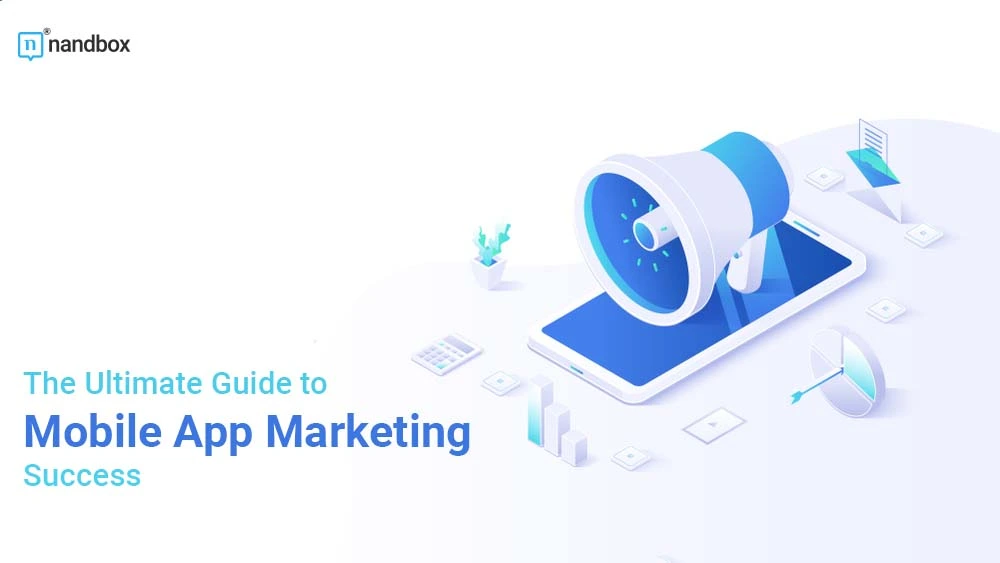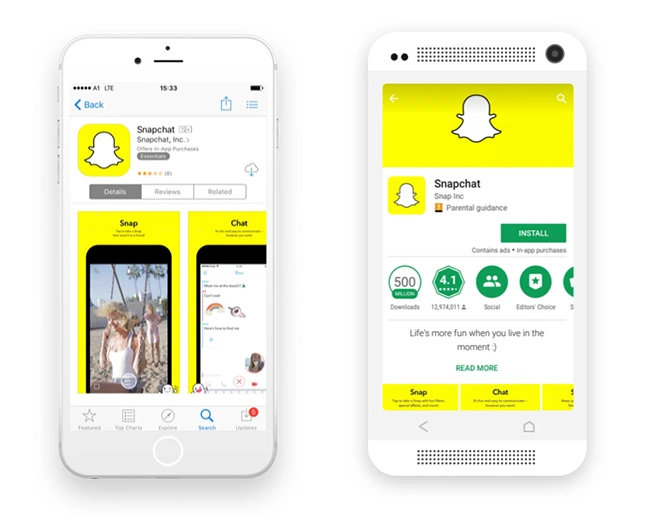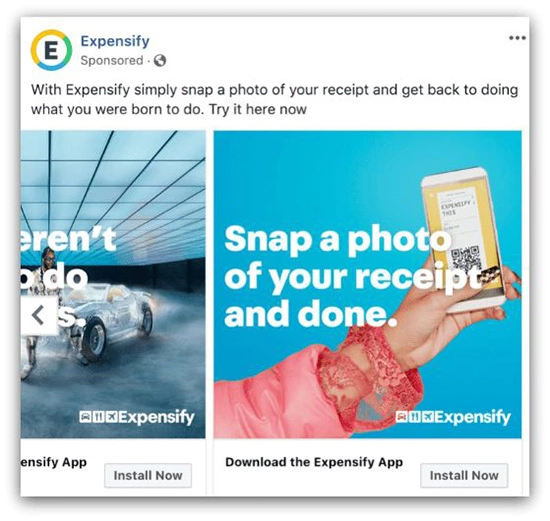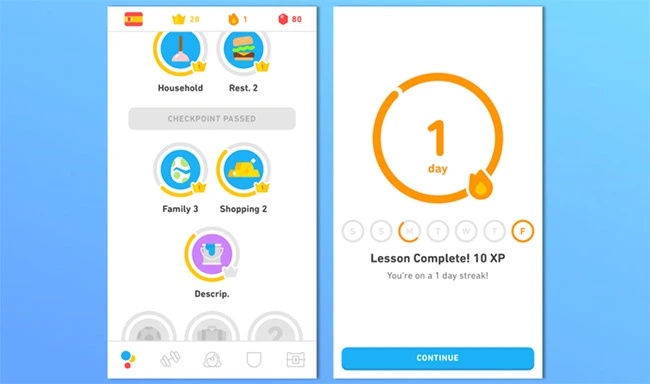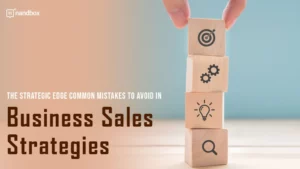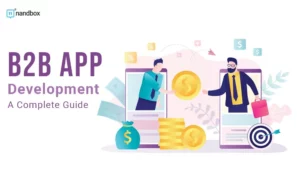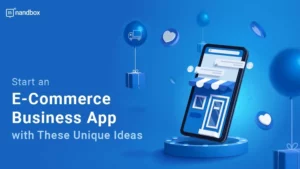No successful app ever reached any level of popularity without extensive marketing. Even apps that seem to have achieved overnight success. With more than 2 million apps in both the App Store and Google Play, standing out isn’t easy. That’s where mobile app marketing comes in. And thanks to word-of-mouth, influencer marketing, and targeted paid advertising, it is possible to market an app more directly. This can deliver great results while also being kinder to your wallet.
Marketing your app effectively can mean the difference between thousands of downloads and none at all.
But where should you begin?
In this comprehensive guide, we’ve compiled the most effective mobile app marketing strategies and tactics to help your app succeed. Whether you need guidance on crafting the perfect app store listing or on using social media and B2B influencer marketing to drive awareness, it is suitable for both new developers—using no-code app builders like nandbox—and established developers. By strategically working your way through this guide, you’ll gain a more complete understanding of mobile app marketing. And be ready to boost your app’s visibility and downloads.
Understanding Your Target Audience
We have previously written about the importance of market research and mobile apps. A serious approach to market research will help you create an app people want to use. But it will also give you valuable data you can use in your marketing strategy.
In addition to helping you refine your target audience, marketing research is going to surface valuable data on user demographics. You will know more about:
- Their interests.
- How your app will appeal to them.
- Where they are most likely to be exposed to marketing.
The needs and wants of your audience should inform both your app development and marketing. You should have used a lot of the information to develop your app. And now you can use it in your marketing strategy.
Start by working on your messaging. A benefits-heavy approach is best. Focus on both how users will benefit from the app overall and on specific features and their benefits. Then try to establish which channels are going to be best for reaching your target audience. Are they most likely Facebook, Snapchat, TikTok, or Instagram users? Or do they spend more of their free time on YouTube?
Marketing research is not a precise practice, and it won’t give you all the answers you are looking for. But it will help you understand where to focus most of your marketing efforts. Just don’t exclude potential users completely—users who don’t have a lot in common with your target audience. Additionally, you need to know that people change. So, your target audience won’t stay the same. Monitor specific metrics and continue with market research on a smaller scale. This will allow you to pick up any shifts and adjust your marketing accordingly.
Optimizing Your App Store Listing
Your app store listing will play a crucial role in the success of your mobile app. And like the rest of your mobile app marketing, consider it a work in progress. This doesn’t mean that you start off with a poor store listing and improve it over time. Your app store listing should include a lot of detail and appeal to users. But as you learn more about actual users, you can optimize it to gradually reach a larger audience.
But what are the basics you should always focus on?
The App Icon
One of the first things users see is your app’s icon. Your app icon should be visually appealing and properly represent your app, wherever it is displayed. Complex designs, colors, and the inclusion of text doesn’t work well. especially when scaled down.
Screenshots & Videos
Screenshots and videos are great ways to showcase specific features of your app. And they also give users a sense of what they can expect. Choose screenshots that show the user journey, and features, and give a sense of the UX. They should always be high-resolution images. Videos are an ever-better way to show off features and benefits.You can easily create product videos using any tool that lets you edit videos online. Just make sure to keep the video short, but avoid rapid edits that jump between screens too quickly. Keep the video short, but avoid rapid edits that jump between screens too quickly.
The App Description
Your app description should sell your app. Avoid using buzzwords and cliches, focusing instead on highlighting key features and benefits in the opening paragraph. Further down in the description, you can include a more extensive list of features, along with supported languages. Use relevant keywords throughout your description, which can help with the discoverability of your app.
Keyword Optimization
As with SEO, thoroughly research the keywords relevant to your app and that users are most likely to use. Build links with authority sites for these keywords and conduct backlink monitoring. Try to include the most relevant ones in your app title, description, and other metadata, including your screenshots and video captions. But avoid stuffing these with keywords.
App Ratings & Reviews
Positive ratings and reviews can improve the visibility of your app in the app stores. Naturally, when you first launch your app, you won’t have any. But you can encourage users to rate and review your app in its description and—in moderation—in the app itself. Don’t nag users to rate or review your app. Once users start to rate and review your app, set aside time to regularly respond to them. You should respond to both positive and negative reviews because both could contain suggestions for improvement. or even highlight a bug you overlooked. Responses to reviews show potential users that you engage with your audience and value their feedback.
Localization
Is your app only available in a specific location, or is it available in multiple locations? If it is available in different locations, your app store listing should be available in multiple languages. This allows you to appeal to—and attract—users who don’t speak the primary language of your app.
App Size & Requirements
Make sure you know the size of your app and the devices and operating systems it works best on. You should then include this information in your app store listing. Many users may still have older devices that lack certain features or don’t support the latest operating system. That way, you won’t waste anyone’s time downloading an app that won’t work on their device.
Compare & Revise
Throughout the development of your app, you would have been comparing it to that of competitors. And you should repeat this when it comes to your app store listing. Look at the listings for apps you know are competitors and for any similar apps. See what they are doing differently that you could emulate without copying. You want to stand out from your competition.
Use App Analytics
Tracking the performance of your app listing is the best way to continually improve it. Both Apple and Google provide developers with key metrics on the performance of their app store listings. This includes the number of visitors or impressions, the number of installs, and the conversion rate. If you’re attracting many visitors but they aren’t converting, you need to try to establish where the fault is.
A/B Testing
The best way to establish if your store listing is failing to convert visitors is with A/B testing. This allows different app store listings to be shown to different users to see which one converts more users. Unfortunately, both Google and Apple limit the variations to app icons, screenshots, and videos. But these can still have a dramatic impact on your conversions.
Apple has recently launched Custom Product Pages (CCPs), which allow you to create entirely different landing pages. Instead of just having a different icon, screenshot, or video, even the page text can be different. However, this feature is only available as part of a paid Apple Search Ads campaign. But these could still provide valuable insight into what page copy leads to better conversions. And you can then apply this to your actual app store listing.
Beginning with an optimized app store listing is a crucial part of mobile app marketing. But like so much else related to app development, it is a continuous process. You are going to constantly monitor analytics and best practices and apply changes to your listing. With the aim always being to improve visibility and drive more downloads. Depending on how familiar you are with general SEO, you might know that search algorithms are constantly being tweaked. Search on both app stores is no different. And any changes to the algorithms can affect your visibility. So, don’t neglect to optimize your app store listing regularly.
Using Social Media
Used smartly, social media is a powerful tool for mobile app marketing. With social media, you can reach a large audience and promote your app cost-effectively. Tips to help you do this include:
- Know your target audience: By this stage, you hopefully already have a good idea of who your target audience is. And what their preferred social media platforms are. Focus first on the platform(s) where your audience is most active. This will also help you understand the type of content they enjoy or respond to.
- Create a social media presence: You might already have a social media presence, but your app doesn’t. And you need to use your app’s profile when promoting it. Twitter, Instagram, and Facebook are great options for any type of app. But only consider LinkedIn, Pinterest, Snapchat, and TikTok if your target audience uses any of them. If your audience is on TikTok, you must learn how to go viral on TikTok to build engagement with your brand. Ensure the profile on each platform is complete and begin posting regular updates. These could include posts about individual features, along with posts about specific benefits of the app. Make sure you design each post to appeal to your target audience. You should also tailor it for each platform. You want to create interest in your app and build a following. Later you can also use WhatsApp and Facebook Messenger for app support.
- Create engaging content: You are trying to build a following and have your app exposed to many potential users. The content you create shouldn’t only be engaging, it should also be shareable. If you’re posting content on platforms like Instagram, create engaging captions with relevant hashtags to boost your post visibility. You can use an IG caption generator to assist you in making the perfect caption for your posts. And post the type of content your audience enjoys. Know whether they prefer short videos or posts that mix text and images. Once your app has launched you can start including user-generated content, reviews, and user stories. These will help build trust.
- Use Influencer marketing: Engage with influencers in your industry or whose audience is similar to your target audience. The idea is to partner with them. But you first need to establish if there is interest, and what the cost would be. Influencers who are themselves similar to your target audience could also provide valuable feedback on your app. Outside of that, if they agree to promote your app, you can expect them to generate considerable interest.
- Run social media contests and giveaways: You can keep driving interest and downloads with contests and giveaways on social media. Contests can not only attract new users, but they can also reward existing users. Not forgetting they’re a great way to get user-generated content that you can use to promote your app.
- Use paid social media promotion: Look at each platform’s advertising options. But run campaigns only on the platform your target audience is most active on. This is especially great for targeting specific demographics and locations with more precision. It is another way to have your app exposed to more potential users who aren’t already aware of your app.
- Track and measure all your efforts: Use all the analytics you can access. It is important to measure the performance of your app and app marketing tactics. You don’t only want to see that your efforts are having a positive effect. You also want to be able to tell which platforms and content types perform best. All popular social media platforms have their own analytics tools which you can access once you’ve created a profile.
- Use social media to improve customer support: Social media can be hugely beneficial for customer support and user feedback. If possible, encourage users to ask support-related questions on social media, along with providing feedback or reporting issues. It offers a sense of transparency and immediacy lacking in email and other types of support.
App Store Optimization (ASO)
The SEO of the app store, App Store Optimization (ASO) is all about optimizing your app’s listing. By doing this you can improve visibility and discoverability, and drive more downloads. In one of our upcoming posts, we will take a deep dive into ASO and how to master it. This will include:
- Identifying the right keywords.
- Tweaking your app’s listing title and subtitle.
- The impact of reviews and ratings.
- Use of paid promotion and buying backlinks.
- Tools for tracking and measuring your ASO efforts.
ASO warrants its own piece because it is crucial to your app’s visibility. App store searches can be a big source of new downloads without any effort from you.
Leverage Paid Advertising
The reality of most marketing in the digital age is that paid advertising must be part of the mix. This is true too when marketing your mobile app. However, unlike the other strategies mentioned in this guide, it shouldn’t be a big part of it. Use it to supplement and boost all other marketing activities but avoid making it the focus. Tips to help you get the most benefit out of paid advertising include:
Choose the Right Platforms
Google Ads are no longer your only option for paid advertising. Depending on your target audience, Instagram, Facebook, and Apple’s Search Ads can be effective too. There are pros and cons to each platform. But your main interest is in using the platform that is most likely to reach your target users. You can even use the Meta ads library to find the relevant and industry-aligning options, save ads, resize and reshape them and use them for your own campaigns.
Use Targeted Advertising
Thanks to the market research you have carried out, you know a lot about your target audience. You know what their general interests are, online behavior, locations, and more. With these, you can set your ads to target people who are most likely to show interest in your app. You can occasionally target users whose demographics are close to your ideal user but don’t set your parameters too broadly.
Eye-Catching Images & Video
Use eye-catching, visually appealing images and videos that will grab the attention of your target audience. But ensure they also properly showcase your app and its features. Support these with appropriate copies where necessary. And always include a clear and compelling call-to-action (CTA) that links to the relevant app store listing.
Optimize With A/B Testing
You can leverage A/B testing to optimize your ads. Test different headlines, images, and CTAs to which drives the most conversions, measured as downloads. Remember that with A/B testing you are only changing one thing at a time. So, your ad variations will either have a different headline, a different image, or a different CTA. Not different versions of all three in a single ad.
Use Retargeting
Sometimes users will respond to an ad by watching the video, leaving a comment, or clicking through to the store listing. But they stopped short of installing the app. With retargeting you can reach these users again to remind them about your app and encourage them to download it. It isn’t a hard sell but rather a gentle nudge or reminder. They might have stopped short of installing your app for a number of reasons.
Monitor & Measure
Lastly, continually monitor and measure the performance of your campaigns. All advertising platforms give you full access to performance metrics for each campaign you have running. These can help you make data-driven decisions and optimize campaigns for maximum impact and ROI.
Always remember to use paid advertising in conjunction with all your other marketing strategies. A multi-faceted approach to mobile app marketing allows you to reach a larger audience. And drive more downloads.
App Retention and Engagement
No mobile app marketing strategy is complete without a strategy for driving retention and engagement. Your success doesn’t depend solely on users installing your app. It also needs users to keep using your app.
Have a Great User Experience
A poor user experience (UX) is not going to keep users coming back to your app. They will quickly abandon your app and uninstall it if your app:
- Isn’t visually appealing.
- Doesn’t provide value.
- Isn’t easy to navigate.
Regular user testing is necessary to gather feedback on all aspects of your app, allowing you to continue making improvements.
Personalize the Experience
You can use usage history, location, and user preferences to personalize the app experience for each user. This includes showing users personalized content and personalizing push notifications and in-app messages. If you have a promotion on women’s dresses, send push notifications only to users who have previously bought a dress.
Push Notifications
Push notifications are an effective—and low-cost—way to reach users. Use them to promote new content, new products, features, or promotions. But don’t overuse them, which is likely to drive users to disable them or uninstall your app.
Encourage User-Generated Content
User-generated content (UGC) can include reviews, ratings, and customer testimonials. They’re important in terms of ASO, but you can also use them elsewhere to build trust and increase engagement. Effective client testimonials, for instance, instill credibility and establish trust, making them an indispensable part of your marketing tool kit. These testimonials, when genuinely positive, showcase the value and impact of your app, encouraging further usage and downloads. Include user reviews and ratings in some of your social media posts, and even on your app’s website.
Experiment With Gamification
The use of points, badges, and leaderboards in a non-game context can make your app more fun and engaging. But it isn’t suitable for all apps. See if there is a way for you to incorporate gamification elements into your app. Experiment with these to see if they produce positive results, but don’t force them.
Measure & Analyze Retention and Engagement
Flurry, Amplitude, Firebase, Mixpanel, and other app analytics platforms can all help you monitor retention and engagement. In some cases, you can also use them to drive engagement. You can track and monitor daily active users (DAU) and monthly active users (MAU), along with retention rates. But you can also identify patterns and trends, allowing you to make adjustments to boost retention and engagement.
Encourage Feedback
User feedback can be invaluable in terms of retention. If you don’t know what aspects of your app users don’t like or they feel don’t add value, you can’t fix them. And a flawed app does not retain users. Make sure users can submit feedback in multiple ways:
- Using social media, WhatsApp, or Facebook Messenger.
- Via email.
- In reviews.
- Via a support platform such as Zendesk.
Respond to user feedback in a timely manner, showing that you value their feedback, and action it. When communicating via email, utilize an email verifier to maintain up-to-date and valid email addresses to enable prompt responses to user feedback.
Keep Your App Updated
One of the surest ways to lose users is to not update your app. App updates needn’t only involve the rolling out of new features. Any bug fixes and security updates also warrant a new version release. Whenever Apple or Google releases a new version of their OS, you need to verify that your app still works. You don’t need to update it weekly but avoid going longer than three to six months without any updates.
By following the above tips, you can easily increase retention and engagement. Keeping users coming back for more.
Mobile app marketing is a crucial aspect of ensuring the success of your app. Together, all the steps compiled in this guide address the main stages of mobile app marketing:
- Awareness
- Acquisition
And these apply no matter how you go about developing your app. From using nandbox, to coding the app yourself. As you follow each, remember to always measure and analyze the performance of your actions. This allows you to continually make data-driven decisions to boost awareness, acquisition, and retention. Increasing your chances of mobile app success.

